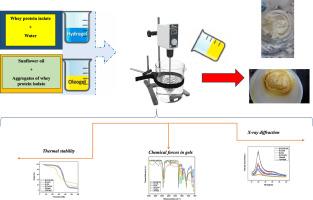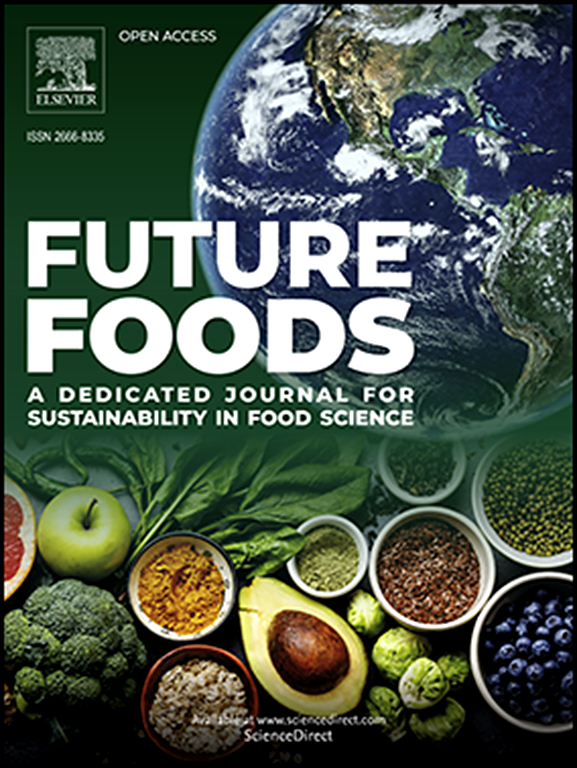基于乳清蛋白的姜黄素和没食子酸胶囊:特性、稳定性和释放动力学
IF 7.2
Q1 FOOD SCIENCE & TECHNOLOGY
引用次数: 0
摘要
大胶囊是一类软物质系统,作为食品类似物或增强型配料替代物,在食品工业中大有可为。这项工作旨在通过将姜黄素(CUR)和没食子酸(GA)共同包囊在大胶囊中,提高它们的稳定性、抗氧化能力和控释性。这种给药系统包括由基于乳清蛋白分离物(WPI)聚合体的油凝胶和基于 WPI 的水凝胶按等量(50:50)制成的 bigel。我们采用了以下技术来评估不同的大凝胶如何影响 CUR 和 GA 的化学稳定性:X 射线衍射 (XRD)、热重分析 (TGA)、1H-核磁共振 (1H-NMR) 和傅立叶红外光谱 (FTIR)。由于蛋白质的配体结合能力,某些成分可能会共同吸附在油滴表面。接下来,研究人员确定了 bigels 作为载体的性能,并考察了它们的理化稳定性、消化率和性能。对 CUR 和 GA 在消化过程中的释放率进行的研究表明,bigel 的释放率(6-15%)比油凝胶(16%)和水凝胶(34%)慢,CUR 的释放率(50%)比 GA 的释放率(70%)低,这是因为 CUR 的分子量较高,缠结程度较大。Bigel 的稳定性(耐热性和耐光性)也高于油凝胶和水凝胶,这是因为其固体成分较高,需要对系统施加更大的压力。CUR和GA在bigel中的抗氧化活性(96.24%)高于油凝胶(77.71%)和水凝胶(77.34%);这可能是由于bigel形成了超细胶体分散体,使更多的CUR和GA有更多的接触面与自由基相互作用。多功能 bigels 在向肠道输送抗氧化剂方面显示出巨大的潜力,同时提高了其稳定性。傅立叶变换红外光谱分析验证了 WPI 与 CUR-GA 之间的疏水相互作用和氢键作用,从而保持了 bigels 的稳定性。总之,我们的研究结果表明,基于 WPI 的 bigels 可以开发出具有令人信服的紫外线、颜色和热稳定性的产品。这将增加大胶粒在具有高营养价值的创新食品中的应用。本文章由计算机程序翻译,如有差异,请以英文原文为准。

Whey protein-based bigels for co-encapsulation of curcumin and gallic acid: Characterization, stability and release kinetics
Bigels are a class of soft matter systems with great promise for the food industry as food analogs or as enhanced ingredient substitutes. This work aimed to improve the curcumin (CUR) and gallic-acid (GA) stability, antioxidant capabilities, and controlled release by co-encapsulating them within bigels. This delivery system included a bigel made by whey protein isolate (WPI) aggregates-based oleogel and WPI-based hydrogel in equivalent amounts (50:50). The following techniques were used to evaluate how different bigels affected the chemical stability of CUR and GA: X-ray diffraction (XRD), thermogravimetric analysis (TGA), 1H-nuclear magnetic resonance (1H-NMR), and Fourier infrared (FTIR) spectroscopy. As a result of the protein's ligand-binding abilities, some components may co-adsorb to oil droplet surfaces. Next, it was determined how well the bigels performed as a carrier and looked at their physicochemical stability, digestion, and performance. Examining the release rate of CUR and GA during digestion showed that bigel had a slower release rate (6–15%) than oleogel (16%) and hydrogel (34%), and CUR had a lower release (50%) due to its higher molecular weight and greater entanglement than GA (70%). The stability of bigel (against heat and light) was also higher than oleogel and hydrogel due to having a higher solid component that requires more stress to be applied to the system. CUR and GA had more antioxidant activity in bigel (96.24%) than oleogel (77.71%) and hydrogel (77.34%); which can be attributed to the formation of ultra-fine colloidal dispersions by bigel, allowing more CUR and GA to interact with free radicals by creating more contact surface. The multi-functional bigels showed great potential for delivering antioxidants to the intestine while enhancing their stability. Hydrophobic interactions and hydrogen bonding between WPI and CUR-GA were validated by FTIR analysis, that kept bigels stable. Overall, our findings demonstrated that WPI-based bigels with intriguing UV light, color, and thermal stability could be developed. This would increase the use of bigels in innovative food products with high nutritional value.
求助全文
通过发布文献求助,成功后即可免费获取论文全文。
去求助
来源期刊

Future Foods
Agricultural and Biological Sciences-Food Science
CiteScore
8.60
自引率
0.00%
发文量
97
审稿时长
15 weeks
期刊介绍:
Future Foods is a specialized journal that is dedicated to tackling the challenges posed by climate change and the need for sustainability in the realm of food production. The journal recognizes the imperative to transform current food manufacturing and consumption practices to meet the dietary needs of a burgeoning global population while simultaneously curbing environmental degradation.
The mission of Future Foods is to disseminate research that aligns with the goal of fostering the development of innovative technologies and alternative food sources to establish more sustainable food systems. The journal is committed to publishing high-quality, peer-reviewed articles that contribute to the advancement of sustainable food practices.
Abstracting and indexing:
Scopus
Directory of Open Access Journals (DOAJ)
Emerging Sources Citation Index (ESCI)
SCImago Journal Rank (SJR)
SNIP
 求助内容:
求助内容: 应助结果提醒方式:
应助结果提醒方式:


